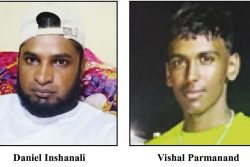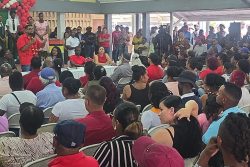President Bharrat Jagdeo’s official visit to Venezuela last July was long on the economy and short on a strategy to resolve the thorny territorial controversy between the two neighbours. As President’s Cheddi Jagan discovered when he met President Rafael Caldera in October 1995 and as President Janet Jagan learnt on her July 1998 visit to Caracas, the territorial controversy is not a matter for the uninformed and inexperienced.
As soon as the last British troops left Guyana in October 1966 – Guyana’s independence year – the Venezuelan National Armed Forces seized the 7-km² Ankoko Island in the Cuyuni River. It has remained in illegal occupation ever since. The island is used as a military garrison to harass Guyanese miners and to engage in occasional acts of provocation against the Guyana Defence Force border detachment at Eteringbang on the opposite bank of the river. But the symbolism of the occupation of Ankoko has been a bone in the throat of Guyanese negotiators ever since and has intoxicated Venezuela’s diplomats with delusions of superiority.
Venezuelan leaders seem to derive satisfaction from the simmering dispute and evince no interest in attempting a solution. In the hands of President Hugo Chávez Frías and his successive ministers of external relations, the territorial issue has become a useful instrument of ‘finlandisation.’ Through veiled threats and subtle pressures and small concessions about commodities, Venezuela has sought to establish itself as the arbiter of Guyana’s development of the entire Essequibo that it still refers to as its zona en reclamación. Weak Guyanese diplomats and ministers seem to satisfied with their impotence.
The most brazen example of that policy was President Chávez’s angry opposition to the proposed Beal Aerospace Technologies project in the Barima-Waini Region a decade ago in 2000. President Chávez at that time intervened personally to destroy the agreement between the Government of Guyana and Beal Aerospace Technologies Inc which aimed at establishing a satellite launch station in the Barima-Waini Region.
He suggested implausibly that that the planned station would be a ‘Trojan horse’ that threatened Venezuela’s security by enabling the United States to establish a ‘military base’ along his country’s vulnerable eastern flank. President Jagdeo met President Chávez at a conference of South American leaders in Brasilia shortly afterwards and pleaded, “I gave him a copy of the contract so that he could see for himself that there is no intention, or anything written into it, that would allow the establishment of an American base.” Alas, to no avail. Chávez’s pugnacity prevailed.
President Chávez who entered office in 1998 and was re-elected in 2000 and 2006 has become familiar with the style and strengths of President Jagdeo who entered office in 1999 and was re-elected in 2001 and 2006. As if by mutual agreement, they make little mention of the sovereignty question. There are two exceptions, though.
One is the UN Good Officer process. Both presidents ritually reaffirm their confidence in the United Nations Secretary General Good Offices Process as a mechanism that would assist the parties to advance towards a practical and satisfactory solution for the border issue, without affecting good bilateral and regional relations. Both Presidents, on the occasion of Mr Jagdeo’s latest visit, welcomed the appointment of, and expressed their confidence in, the work of Professor Norman Girvan as the Personal Representative of the United Nations Secretary General responsible for the Good Offices Process. President Jagdeo announced the designation of the Honourable Ralph Ramkarran as Guyana’s Facilitator and President Chávez announced the designation of Ambassador Roy Chaderton as the Facilitator for Venezuela.
The other exception has not been so serene. Venezuelan administrations invariably seize every opportunity to iterate their doctrine of dominance over its smaller eastern neighbour, behaviour which it cannot display towards Colombia or Brazil.
Since his accession to office, President Hugo Chávez has made no attempt to conceal his personal posture on Venezuela’s territorial claim. During his state visit to Guyana in February 2004, he told the press plainly that his administration would have no objection to such infrastructure as roads, water and electricity that directly enhance the lives of residents. Strategically sensitive projects – including major offshore oil exploration ventures, mineral exploration or the involvement of foreign governments – were another matter. They should, he said, be discussed within the framework of the High-Level Bilateral Commission (Comisión Bilateral de Alto Nivel). President Chávez’s doctrine, in short, has been that Venezuela must have a role in determining the developmental destiny of Guyana’s Essequibo.
President Jagdeo, therefore, on his recent visit to Venezuela, stuck to advancing his economic agenda by small incremental steps as best he could. His visit, as a result, culminated in lots of low-level agreements. These include two memoranda of understanding between Guyana’s Ministry of Foreign Affairs and Venezuela’s Energy and Petroleum Ministry for the supply of fertilizer and fuel; a memorandum of understanding for the creation of a Committee for the Prevention, Investigation and Settlement of Fishing Incidents; a Letter of Commitment between Venezuela’s People’s Power for Food and Guyana’s Ministry of Agriculture and agreements for the increase of the supply of polished rice to Venezuela from 50,000 tonnes and paddy to 70,000 tonnes.
The possibilities of purchasing fertilizers, aviation fuel and Veniran tractors were also examined and it was agreed that Guyana will become an observer to the Bolivarian Alternative for the Americas. This could lead, possibly, to increase the volume of petroleum that Guyana could receive from Venezuela through the PetroCaribe facility.
In other discussions, President Chávez informed President Jagdeo of the recent approval of the necessary resources for carrying out the exercise of updating the hydrographical data of the Mahaica, Mahaicony and Abary rivers in Guyana, needed to execute the dredging works in cooperation with Venezuela. The Presidents discussed the Initiative for Integration of Regional Infrastructure of South America (IIRSA) initiative and reiterated their commitment to the realisation of its objectives.
They endorsed the proposal for a Guyana-Venezuela road link and agreed to seek, jointly, international resources to conduct the feasibility studies needed to implement this proposed project. The Presidents noted the importance of creating an environment to allow for the realisation of the economic potential of the areas that would be opened up as a result of the proposed road link agreeing to adopt policies and measures that would encourage economic activities to ensure the viability of the proposed road link. They mandated their respective Foreign Ministries to work on the convening of the High-Level Bilateral Commission to be held in Caracas.
President Jagdeo’s visit is over but it represents an opportunity missed and a road not taken. Agreements about rice, fertilizer, fuel and tractors and the like are important but do not necessarily require a state visit for their accomplishment. Strategic issues such as the territorial controversy require deeper thought. They cannot be postponed forever.
Venezuela’s claim extends over such a vast area of Guyana’s resources that it cannot be ignored by local or even global, policy-makers. Venezuela’s concerns about riverine pollution and environment degradation caused by Guyanese wild-west mining methods might have some foundation.The South American Initiative for Regional Infrastructural Integration might also transform Guyana’s hinterland and should also be given serious thought. Unlike the slothful attitude shown towards the road to Brazil, the road to Venezuela that is being planned from Ciudad Bolivar, across the Cuyuni-Mazaruni Region to Bartica and on to Linden and Suriname should be acted upon quickly. The menace of international narcotics-trafficking, gun-running, fuel-smuggling and trafficking in persons and measures to counter piracy, maritime poaching and illegal mining should not be avoided.
Much better could have been done to make the visit a diplomatic success. It is a pity that the Guyana side did not prepare better for such an important visit. Apart from the territorial issue, several other trans-border issues should be settled before they degenerate into forceful confrontations. Nobody wants conflict but pre-emptive agreement is needed to forestall worse problems.








